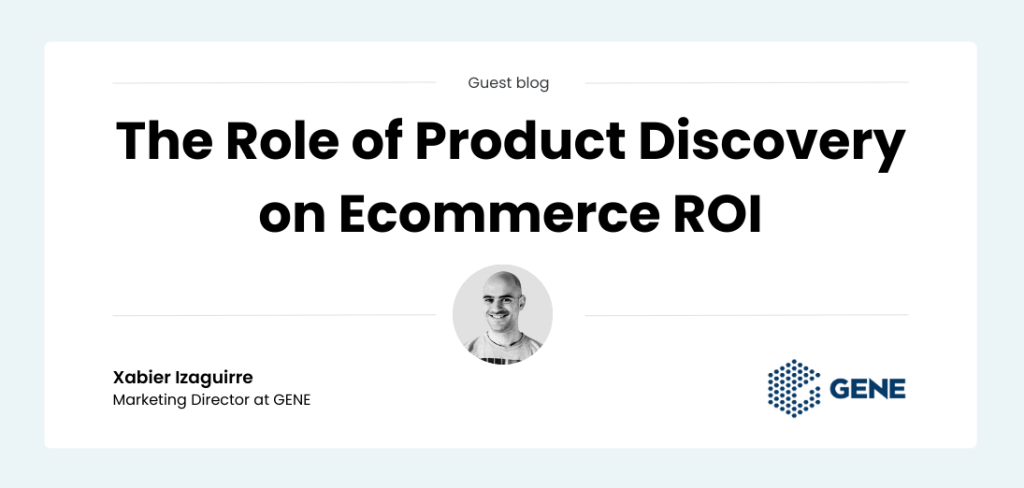Blog
The role of Product Discovery on Ecommerce ROI

Ecommerce stores are designed to support the customers’ key objectives: browse the catalogue, check products, learn about the company that sells them, and finally, pay for them.
These customer journeys are not always linear. However, it’s useful to think of them in a primarily forward motion: visit the site, view an item, put it in the basket and checkout with it.
With this particular lens, you can see the role of ecommerce store functionality as one of “clearing the path ahead” and “helping customers move forward”. This focuses the mind on all the steps we need to help customers take on their way towards the confirmation page.
This article is about the specific role that Product Discovery plays in helping customers move forward in this pseudo-linear process.
What is Product Discovery?
Product Discovery, in the context of ecommerce, is the process by which customers find, or stumble upon, products online.
Product Discovery is supported by a range of store features: site search, category navigation, merchandising and recommendations all play a role in helping users navigate a catalogue and find the items they were looking for (and some they didn’t know they were looking for).
Think about it this way: in a traditional high-street store, customers can discover products naturally. For example, by walking around aisles (the equivalent of category navigation and online merchandising), as well as talking to sales assistants (the equivalent of site search and recommendations).
And this is what makes shopping in-store an enjoyable experience: discovering and finding products is effortless, and there is plenty of help available.
If only we could replicate that experience online…but without items in the wrong aisle, the queues at the till, or the screaming children.
How Product Discovery helps with Ecommerce ROI
Ecommerce Return on Investment (ROI) is a metric that measures the rate at which financial investment results in financial returns. In other words, how much you get per pound/dollar invested.
Ecommerce user experience design and development is an investment and can be evaluated from an Ecommerce ROI point of view. For example, does implementing a new site search engine deliver on ROI?
Product Discovery helps Ecommerce ROI by making it more likely that a customer will find a product that meets their objectives, and consequently, buy it.
The way this works depends on the Product Discovery tactics:
- Site search: Returning better results for customers and therefore making item views and add-to-baskets more likely.
- Merchandising: Present product lists/grids in the most attractive way possible, making item views more likely and decreasing exit rates.
- Recommendations: Offer relevant product recommendations at different points of the purchase cycle to increase likelihood of conversion, as well as average order value.
Capitalising on customer’s intent with smart search
Search matters.
If people are searching for an item, it’s because they have a clear idea of what they want to buy, ie, they have “more intent”.
Customers with high intent are more important because they’re more likely to convert.
Approximately 15% of sessions include a search (source: IMRG + Capgemini), however, revenue from sessions with a search can account for 30 to 50% of a site’s revenue, depending on the sector.
Additionally, we also know that the longer the search query (how many attributes are in it), the higher the likelihood of purchase, which again, is intuitive: people searching for “skirts” are less likely to convert than someone searching for “green skirts below £30”.
To make the most revenue from sessions with search, you need to think about two things:
- One, your search bar is prominent and it features a clear call to action. This way, customers can be encouraged to search, kicking off a more intentional journey.
- Two, make sure your search engine returns relevant results for the query. For this, you need to make sure there’s a semantic understanding so that attributes such as colour and price return relevant results with those attributes.
Making merchandising work harder
Merchandising is the display of products in a store, a window, or in the case of ecommerce, on a Product Listing Page (PLP)
The role of ecommerce merchandising is to effectively move the customer from a Product Listing Page (PLP) into a Product Description page (PDP). Merchandising works together with category navigation features such as filters to accomplish this.
Good merchandising makes use of behavioural data to understand what products are people most likely to buy, for example, conversion data. Then, displays them in that order.
On average, 56% of online shoppers visit a product page (Source: IMRG + Capgemini 2021); all things being equal, smart merchandising can bring more people into product pages, taking customers further down the funnel and increasing opportunities for personalisation.
This is, therefore, another key area for ROI-driven development.
Recommendations
Recommendations play two essential roles: increase the likelihood of conversion, and increase average order value.
Recommendations can follow different types of logic, and be used in different stages of the purchase journey.
For example, trending products and best-sellers can work well in the early stages (eg, homepage) where we still don’t know much about the user (since we don’t have a lot of behavioural data). These types of recommendations make conversion from the homepage more likely.
In further stages, such as PDPs and baskets, recommendations need to be more relevant to the customer, as the system has now enough data to make specific recommendations.
Now, we can consider recommendation tactics such as “also bought together”, which works great on the basket, or “similar products” which works better on the PDP. For ecommerce stores with big-ticket items or designer lines, handpicked cross-sells might work better at increasing AOV, whilst delivering a superior shopping experience too!



